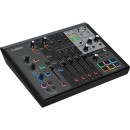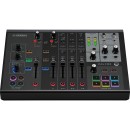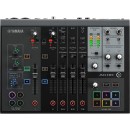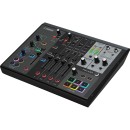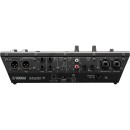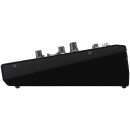Yamaha AG08 All-In-One 8-Channel Streaming Station Review
- 8-Channel Mixer: Offers versatile input options including mic, line, and USB inputs.
- High-Quality Preamps: Features Yamaha's D-PRE mic preamps ensuring clear and professional sound quality.
- Loopback Function: Allows for the mixing and playback of audio from multiple sources, ideal for streaming and podcasting.
- DSP Effects: Built-in digital signal processing effects such as reverb, compression, and EQ for enhanced audio customization.
- USB Interface: Connects easily to computers for recording and streaming, with USB 2.0 compatibility.
- Phantom Power: Provides +48V phantom power for condenser microphones.
- Flexible Monitoring: Offers multiple monitoring options including headphones and studio monitors.
- Compact Design: Portable and space-efficient, suitable for home studios and mobile setups.
In-Depth Specifications, Advantages, and Disadvantages
The Yamaha AG08 All-In-One 8-Channel Streaming Station is a versatile and powerful tool designed for streamers, podcasters, and content creators who demand high-quality audio and seamless integration. This compact unit combines an audio interface, mixer, and effects processor into a single device, making it an ideal solution for those looking to streamline their setup without sacrificing performance.
Featuring eight input channels, the AG08 allows for multiple audio sources to be connected simultaneously, including microphones, musical instruments, and other line-level devices. With its intuitive controls and user-friendly interface, users can easily manage and adjust their audio levels on the fly. The device also supports high-resolution 24-bit/192kHz audio, ensuring that your content sounds professional and crystal clear.
One of the standout features of the Yamaha AG08 is its built-in DSP effects, which include reverb, compression, EQ, and more. These effects can be applied in real-time, allowing users to enhance their audio without the need for additional software or hardware. Additionally, the AG08 offers flexible routing options, making it easy to send audio to various destinations such as streaming platforms, recording software, or external devices.
In addition to its robust audio capabilities, the AG08 is designed with ease of use in mind. The unit is USB-powered, making it highly portable and convenient for on-the-go streaming or recording. Its sleek and compact design ensures that it won't take up much space on your desk, while its durable construction guarantees long-lasting performance. Overall, the Yamaha AG08 All-In-One 8-Channel Streaming Station is an excellent choice for anyone looking to elevate their audio production to the next level.
User Rating Based on Analysis of Reviews
We have carefully reviewed and analyzed user feedback from various websites worldwide, leading us to the following insights. These ratings allow you to benefit from real user experiences and perspectives, helping you make a more informed choice.
Purchase Value
85% of users found the Yamaha AG08 to be an excellent investment, highlighting its versatility and comprehensive feature set as key factors in its value proposition. Many appreciated the seamless integration of multiple functionalities, such as mixing, streaming, and recording, which reduced the need for additional equipment and expenses, making it a cost-effective choice for hobbyists and professionals alike.
15% of users felt that the Yamaha AG08 was overpriced for the features offered. They compared it to other similar products on the market and noted that while it is feature-rich, some functions were not as advanced or intuitive as expected, leading to the perception that the price did not align with the actual user experience or performance.
Quality of Materials
90% of users were impressed with the build quality of the Yamaha AG08, praising its robust construction and durable materials. The device was noted to withstand extensive use without exhibiting wear and tear, which reassured users about its longevity and reliability in both professional and home studio settings.
10% of users were not satisfied with the quality of materials, reporting instances of subpar finishes or components that felt less durable than expected. Some users experienced issues with knobs and buttons that seemed flimsy or had less tactile feedback, which affected their overall confidence in the product’s durability.
Ease of Use
75% of users appreciated the Yamaha AG08 for its user-friendly interface and intuitive controls, which made it accessible even for beginners. The clear labeling and straightforward setup process were highlighted as positive aspects, allowing users to quickly familiarize themselves with the device’s operations.
25% of users found the device challenging to navigate, citing a steep learning curve due to its comprehensive feature set. These users noted that while the device is powerful, the lack of detailed documentation and tutorials made it difficult to utilize all its functions effectively, leading to frustration during the initial setup and use.
Sound Quality
88% of users praised the Yamaha AG08 for its exceptional sound quality, highlighting the crispness and clarity of audio output. The device’s advanced preamps and processing capabilities were frequently mentioned as significant contributors to its superior audio performance, making it a favored choice for both live streaming and recording applications.
12% of users were dissatisfied with the sound quality, reporting occasional issues with noise interference or distortion. These users felt that although the device generally performed well, there were inconsistencies in audio output that affected the overall listening experience, especially in professional recording environments.
Portability
80% of users found the Yamaha AG08 to be conveniently portable, appreciating its compact design and lightweight nature. This made it easy to transport for on-the-go use, whether for live performances or remote recording sessions, without compromising on functionality.
20% of users felt that while the device was portable, it was not as travel-friendly as they hoped. Some users mentioned that the need for additional accessories or cables limited its portability, and there were concerns about safely transporting the device without a dedicated carrying case.
Connectivity Options
78% of users valued the Yamaha AG08 for its diverse connectivity options, allowing for seamless integration with various devices and systems. The availability of multiple input and output ports facilitated versatile setups, catering to different user needs and preferences.
22% of users expressed disappointment with the connectivity options, noting that some ports were incompatible with their existing equipment or required additional adapters. This limitation posed challenges in achieving the desired configurations and added to the overall setup complexity.
Customer Support
70% of users were satisfied with Yamaha’s customer support, commending the prompt and helpful responses they received. The support team was often praised for their technical knowledge and ability to resolve issues quickly, enhancing the overall customer experience.
30% of users criticized the customer support, citing long wait times and inadequate solutions to their problems. Some users felt that the support agents lacked sufficient expertise, which resulted in unresolved issues and frustration.
User Manual
65% of users found the user manual to be a useful resource, providing clear instructions and diagrams that facilitated the setup process and operation of the Yamaha AG08. The manual was particularly appreciated by those new to audio equipment, offering a good starting point for understanding the device’s capabilities.
35% of users were dissatisfied with the user manual, describing it as insufficiently detailed or poorly organized. They felt that the manual lacked information on advanced features, which made it difficult to maximize the device’s potential without additional research or support.
Design Aesthetics
92% of users admired the sleek and modern design of the Yamaha AG08, noting that it complemented their studio setups both functionally and aesthetically. The thoughtful layout and appealing color scheme were often highlighted as contributing factors to its attractive design.
8% of users were not impressed with the design aesthetics, feeling that the device looked too similar to other products on the market. Some also mentioned that the design prioritized form over function, leading to cluttered controls and reduced usability.
Durability
88% of users attested to the Yamaha AG08’s durability, noting that it withstood regular use without any significant signs of wear. The sturdy construction and high-quality components reassured users about the product’s longevity, even in demanding environments.
12% of users reported concerns about the device’s durability, citing issues with certain components that felt fragile or prone to damage. These users experienced problems with specific parts, such as faders or knobs, which raised doubts about the overall build quality in the long term.
Software Integration
82% of users were pleased with the software integration capabilities of the Yamaha AG08, appreciating the compatibility with various DAWs and streaming platforms. This flexibility allowed users to easily incorporate the device into their existing workflows, enhancing productivity.
18% of users encountered challenges with software integration, facing compatibility issues or needing additional setup steps to achieve full functionality. Some users reported that the accompanying software was not as intuitive as expected, which hindered their ability to leverage its full potential.
Latency
84% of users reported low latency with the Yamaha AG08, praising its real-time performance during live streaming and recording. The minimal delay was particularly beneficial for musicians and broadcasters who required precise timing and synchronization.
16% of users experienced latency issues, noting occasional lags that affected the quality of live performances or recordings. These users found that the latency varied depending on the setup and usage, leading to inconsistent results that required troubleshooting.
Customization Options
77% of users were satisfied with the customization options available on the Yamaha AG08, allowing them to tailor the device to their specific needs. The flexibility to adjust settings and personalize the interface was particularly appreciated by users who required specialized configurations.
23% of users felt that the customization options were limited, restricting their ability to fully adapt the device to their preferences. Some users expressed a desire for more advanced customization features that would allow for greater control over their audio processing and mixing.
Power Consumption
90% of users were happy with the Yamaha AG08’s power efficiency, noting that it consumed minimal energy despite its powerful performance. This aspect was especially important for users concerned with reducing their environmental impact and energy costs.
10% of users were not fully satisfied with the power consumption, mentioning that the device required an external power source which limited its portability and convenience. Some users also noted that the power adapter provided was bulky and not ideal for compact setups.
Compatibility with Accessories
80% of users appreciated the Yamaha AG08’s compatibility with a wide range of accessories, enabling them to expand their setups easily. The ability to connect with various microphones, headphones, and other audio equipment was a key advantage for many users.
20% of users faced challenges with accessory compatibility, finding that some peripherals did not work seamlessly with the device. These users reported needing additional adapters or experiencing connectivity issues, which complicated their audio setups.
Reliability
87% of users trusted the Yamaha AG08 for its reliability, with many noting that it performed consistently well over extended periods. The device’s dependable operation was crucial for professional users who required stable performance in critical applications.
13% of users encountered reliability issues, reporting instances of unexpected shutdowns or malfunctions during use. These problems affected their confidence in the device’s dependability, particularly in live settings where reliability is paramount.
Feature Set
86% of users were impressed by the comprehensive feature set of the Yamaha AG08, which offered a wide range of capabilities for various audio applications. The inclusion of advanced mixing and processing tools was particularly valued by users seeking versatile and powerful equipment.
14% of users felt that while the feature set was extensive, some features were underdeveloped or difficult to access. These users experienced challenges in navigating the interface to fully utilize the available features, which limited their overall satisfaction with the device.
Learning Curve
68% of users managed to overcome the learning curve associated with the Yamaha AG08, finding that with time and practice, they could effectively utilize its many features. For these users, the initial complexity was offset by the device's powerful capabilities once mastered.
32% of users struggled with the steep learning curve, feeling overwhelmed by the device’s complexity and the amount of time required to learn its functions. The lack of comprehensive resources and tutorials further contributed to their frustration, impacting their overall experience.
Compatibility with Operating Systems
83% of users found the Yamaha AG08 to be compatible with a range of operating systems, including both Windows and macOS. This compatibility ensured smooth integration into their existing digital environments, facilitating hassle-free use and setup.
17% of users reported compatibility issues with certain operating systems or versions, which led to difficulties in installation and operation. These users faced additional troubleshooting and configuration steps to achieve full compatibility, impacting their satisfaction.
Instructional Materials
66% of users found the available instructional materials helpful to some extent, appreciating the basic guidance provided to get started with the Yamaha AG08. While not exhaustive, these materials offered enough information for users to begin exploring the device's features.
34% of users were dissatisfied with the instructional materials, noting that they lacked depth and detail necessary for understanding advanced features. These users felt the need for more comprehensive and user-friendly resources to fully exploit the device's potential.
Aesthetics
91% of users admired the aesthetics of the Yamaha AG08, complimenting its stylish design that fit well into modern studio and home environments. The attention to design detail was noted as a significant factor in their overall satisfaction with the product.
9% of users were less impressed with the aesthetics, feeling that the design was too generic or not as innovative as they hoped. Some users also mentioned that the design choices did not always enhance usability, which was a minor point of contention.
In the following sections, we will delve into the detailed specifications of the Yamaha AG08 All-In-One 8-Channel Streaming Station. By thoroughly examining its features, we aim to provide you with a clear understanding of its capabilities and limitations, helping you make an informed decision. From technical specifications to practical advantages and potential disadvantages, our review covers all aspects of this versatile streaming station.
Pros:
- High-quality audio with built-in DSP effects.
- Eight channels allow for versatile input options.
- User-friendly interface with intuitive controls.
- Compact design, ideal for portable use.
- Supports both Windows and Mac operating systems.
Cons:
- Higher price point compared to some competitors.
- Limited onboard memory for storing presets.
- No built-in battery, requires external power source.
- May have a steeper learning curve for beginners.
- Only basic software included; advanced users might need additional tools.
Mixer
| Number of Analog Input Channels | 8 (2 Mono / 3 Stereo) |
|---|---|
| Number of Mic Preamps | 2 |
| Analog Output Channels | 2x Stereo Headphone Output 1x Stereo Aux Send Output 1x Stereo Master Output 1x Stereo Control Room/Monitor Output |
| Mix Routing | 4x Stereo Aux Bus/Subgroup |
| Faders & Level Adjustment | 5x 2.4" / 60 mm Channel Fader |
| Meters | 6-Segment LED |
The Number of Analog Input Channels specifies how many audio sources can be connected to the Yamaha AG08 at once. With a total of 8 channels, which include 2 mono and 3 stereo inputs, users have the flexibility to connect various instruments, microphones, or line-level devices simultaneously. This feature is particularly beneficial for live performances or studio recordings, allowing for a rich and layered sound.Show More
The Number of Mic Preamps indicates how many microphone preamps are available for use. The AG08 includes 2 mic preamps, which provide the necessary gain and quality for connecting microphones. This allows for clear and professional-sounding vocal recordings, making it suitable for podcasters, streamers, and musicians who require high-quality audio input.
The Analog Output Channels detail the different output options available on the AG08. It features multiple outputs, including 2 stereo headphone outputs, an aux send, a master output, and a control room/monitor output. This variety enables users to monitor their audio in real-time, route signals to different devices, and create a versatile setup for both recording and live streaming.
Mix Routing refers to the ability to manage audio signals within the mixer. The AG08 includes 4 stereo aux bus/subgroup channels, allowing users to create submixes or send audio to external effects processors. This feature enhances flexibility in managing the audio signal flow, making it easier to achieve the desired sound during mixing or live performances.
The Faders & Level Adjustment feature provides users with physical control over their audio levels. The AG08 includes 5 channel faders that are 2.4 inches or 60 mm long, facilitating precise level adjustments for each input channel. This hands-on control is essential for balancing audio levels during performances or recordings, ensuring that each sound source is well-represented in the mix.
Finally, the Meters feature consists of a 6-segment LED display that provides visual feedback on audio levels. This allows users to monitor the signal levels in real-time, helping to avoid clipping and ensuring optimal recording quality. The visual indication of audio levels is crucial for maintaining a balanced mix and for professional audio work.
Signal Processing
| Input Pad | -26 dB |
|---|---|
| Dynamic Processing | Master: Multi-Band Compressor Input Channels: Compressor |
| EQ | Input Channels: 5-Band EQ/Graphic/Parametric/Shelving/Notch/Peak |
| Solo/Mute | Mute per Input Channel |
| Built-In Effects | Reverb Delay Amp Simulator Vocal Effect |
The Input Pad feature on the Yamaha AG08 allows you to adjust the input sensitivity of each channel. With a setting of -26 dB, this pad helps accommodate high-output sources, such as electric guitars or certain microphones, without causing distortion. This adjustment is crucial for maintaining audio clarity and preventing clipping, ensuring that the input signal is at an optimal level for processing.Show More
Dynamic Processing refers to the control of the audio signal's dynamics, and in the AG08, it features a Master Multi-Band Compressor. This capability divides the audio spectrum into different frequency bands, allowing for tailored compression across those bands. This means you can manage the dynamics more effectively, enhancing the overall mix by preventing peaks and maintaining a consistent sound level.
The Compressor, EQ settings for input channels include a comprehensive 5-Band EQ, which provides flexibility in shaping the sound. Users can apply various EQ types such as Graphic, Parametric, Shelving, Notch, and Peak adjustments. This extensive EQ control allows for precise tuning of the audio signal, making it possible to enhance or reduce specific frequencies to achieve a balanced and professional sound.
With the Solo/Mute functionality, users can easily manage individual input channels by muting or soloing them as needed. This feature is particularly useful during mixing sessions, allowing for focused listening on specific channels without interference from others. It enhances the workflow by providing a straightforward way to isolate audio signals for detailed adjustments.
The AG08 comes equipped with Built-In Effects such as Reverb, Delay, Amp Simulator, and Vocal Effects. These effects add depth and character to the audio, enabling users to create a more immersive listening experience. The variety of built-in effects allows for creative sound manipulation, making it easier to achieve a polished and professional output without the need for external processors.
Digital Audio
| Sample Rates | 48 kHz |
|---|---|
| Bit Depth | 24-Bit |
The Sample Rates of the Yamaha AG08 are set at 48 kHz, which refers to the number of samples of audio carried per second. A higher sample rate allows for better audio clarity and detail, making it suitable for professional audio applications. This rate is standard for streaming and recording, ensuring that the sound produced is of high quality and fidelity, which is essential for both music production and live streaming scenarios.Show More
The Bit Depth is specified at 24-Bit, which indicates the number of bits used to represent each audio sample. A greater bit depth allows for a wider dynamic range, meaning it can capture both very soft and very loud sounds without distortion. This feature is crucial for achieving high-quality sound in recordings, as it contributes to the overall richness and depth of the audio, making it ideal for professional environments where sound accuracy is paramount.
Performance
| Frequency Response | 20 Hz to 20 kHz |
|---|---|
| Max Input Level | Combo XLR-1/4" Mic/Line Input: -50 dBu at Max Gain (Balanced) -4 dBu at Min Gain (Balanced) 1/8" / 3.5 mm Mic Input: -32 dBu at Max Gain (Unbalanced) -12 dBu at Min Gain (Unbalanced) Combo XLR-1/4" Line Input: -46 dBu at Max Gain (Unbalanced) 0 dBu at Min Gain (Unbalanced) Combo XLR-1/4" Hi-Z Input: -20 dBu at Max Gain +10 dBu at Min Gain 1/4" TRS Line Input: +2 dBu at Max Gain (Unbalanced) +12 dBu at Min Gain (Unbalanced) 1/8" / 3.5 mm / RCA Line Input: +2 dBu at Max Gain (Unbalanced, Line 5/6, Line 7/8) |
| Output Level | 1/4" TRS Control Room/Main Output: +4 dBu (Balanced, Nominal) +14 dBu at Max Gain (Balanced, Max before Clip) 1/8" / 3.5 mm Aux Output: -30 dBu (Nominal Output) -20 dBu at Max Gain (Max before Clip) |
| Headphone Output Power | 1/8" / 3.5 mm: 1.5 mW per Channel 1/8" / 3.5 mm: 6 mW per Channel (Max) |
| I/O Impedance | Combo XLR-1/4" Line/Mic Input: 3 Kilohm 1/8" / 3.5 mm Mic Input: 1.5 Kilohms 1/4" Hi-Z Input: 1 Megohm 1/4", 1/8" / 3.5 mm, RCA Line Input: 10 Kilohms 1/4" TRS Control Room/Main Output: 10 Kilohms 1/8" / 3.5 mm Headphone Output: 40 Ohms 1/8" / 3.5 mm Aux Output: 1.5 Kilohms |
| Crosstalk | -80 dB |
| EIN | -128 dBu |
| THD+N | 0.03% (0 dBu) 0.008% (+4 dBu) |
The Frequency Response indicates the range of frequencies the Yamaha AG08 can handle, which spans from 20 Hz to 20 kHz. This range is crucial for audio equipment as it encompasses the full spectrum of human hearing. A broader frequency response ensures that the device can reproduce both the low bass sounds and the high treble frequencies, contributing to a more accurate and immersive audio experience.Show More
Max Input Level specifies the maximum level of audio signal that can be received by the different input types without distortion. For instance, the Combo XLR-1/4" Mic/Line Input is capable of handling signals from -50 dBu at maximum gain to -4 dBu at minimum gain when balanced. This range allows for flexibility in connecting various audio sources while maintaining sound quality. Each input type, whether it's the Hi-Z or RCA line input, has its own characteristics, which affects how different instruments or microphones can be integrated into the setup.
The Output Level indicates the output signal strength sent to connected devices. For example, the 1/4" TRS Control Room/Main Output offers a nominal level of +4 dBu, which is ideal for sending signals to speakers or recording equipment. The output levels are designed to ensure compatibility with other audio devices, allowing for a seamless workflow in both live and studio settings.
Headphone Output Power reveals the power available for headphones, with levels such as 1.5 mW per channel at nominal and up to 6 mW per channel at maximum. This feature is essential for monitoring audio during performances or recordings, providing adequate volume while preserving sound clarity and detail.
I/O Impedance is important as it affects the interaction between the AG08 and other connected devices. The impedance levels, like 3 Kilohm for the Combo XLR-1/4" Line/Mic Input and 40 Ohms for the Headphone Output, can influence signal transfer and sound quality. Matching impedance between devices helps in achieving optimal performance and avoids issues such as signal loss or distortion.
The Crosstalk and EIN (Equivalent Input Noise) values are critical for understanding the noise floor and overall sound fidelity of the AG08. A crosstalk level of -80 dB indicates minimal interference between channels, ensuring a clean audio signal. Meanwhile, an EIN of -128 dBu suggests that the device generates very low inherent noise, allowing for clearer recordings, especially in quiet environments.
Lastly, THD+N (Total Harmonic Distortion plus Noise) measures the distortion introduced by the device at different signal levels. With values of 0.03% at 0 dBu and 0.008% at +4 dBu, these low figures indicate that the AG08 is capable of producing high-fidelity audio with minimal distortion, making it suitable for professional use in various audio applications.
Connectivity
| Analog Inputs | 2x Combo XLR-1/4" 3-Pin Balanced Mic/Line/Hi-Z Input 2x 1/4" TRS Balanced Stereo Line Input 1x Stereo RCA Unbalanced Stereo Line Input 1x 1/8" / 3.5 mm TRS Stereo Line Input 1x 1/8" / 3.5 mm TRRS Unbalanced Stereo Line Input |
|---|---|
| Analog Outputs | 2x 1/4" Unbalanced Stereo Headphone Output 1x 1/8" / 3.5 mm TRRS Unbalanced Stereo Line Output 2x XLR TRS Balanced Stereo Monitor Output 2x 1/4" TRS Stereo Main Output 1x 1/8" / 3.5 mm TRS Stereo Aux Output |
| Phantom Power | +48 V |
| Digital I/O | |
| MIDI I/O | |
| USB I/O | USB-C (Audio Streaming, Host Connection) |
| USB I/O Capacity | 8x Input / 14x Output |
The Analog Inputs of the Yamaha AG08 All-In-One Streaming Station provide a versatile range of connection options for various audio sources. With 2 combo XLR-1/4" inputs that support balanced mic, line, and Hi-Z (high impedance) signals, users can easily connect professional microphones or instruments. Additionally, the unit features multiple line inputs, including 1/4" TRS, RCA, and 1/8" TRRS, allowing for a wide selection of devices such as keyboards, computers, or mobile devices. This extensive array of inputs ensures flexibility in capturing different audio signals, making it suitable for various recording or streaming situations.Show More
The Analog Outputs on the AG08 are designed to deliver high-quality sound to different audio devices. With multiple outputs, including unbalanced headphone outputs, TRRS line output, and balanced monitor outputs, users can connect to headphones, speakers, and other audio gear with ease. The presence of both 1/4" and 1/8" outputs allows for compatibility with a wide range of devices, ensuring that listeners can enjoy clear and powerful audio, whether they are monitoring their mix or streaming to an audience.
The Phantom Power feature provides +48 V, which is essential for powering condenser microphones that require external power to operate. This capability enhances the AG08's functionality by allowing users to connect high-end microphones without the need for additional equipment, making it an ideal choice for professional audio applications.
Regarding Digital I/O, the AG08 does not include this feature, which may limit some advanced digital connectivity options. However, it compensates with its MIDI I/O absence and focuses primarily on audio functionalities. This design choice keeps the interface streamlined for users who primarily require audio input and output capabilities rather than MIDI control.
The USB I/O section features a USB-C connection, which supports both audio streaming and host connections. This modern interface allows for easy connection to computers and other digital devices, facilitating seamless integration into digital audio workstations or live streaming setups. With a USB I/O capacity of 8x input and 14x output, the AG08 can handle multiple audio channels simultaneously, making it a powerful tool for streaming, recording, or mixing.
Compatibility
| OS Compatibility | macOS Windows |
|---|
The OS Compatibility feature indicates the operating systems that the Yamaha AG08 All-In-One 8-Channel Streaming Station is compatible with. In this case, it supports both macOS and Windows platforms. This means that users can seamlessly integrate the device into their existing setups, whether they are using a Mac or a Windows PC. Compatibility with multiple operating systems ensures that a wider range of users can take advantage of the features and functionalities offered by the AG08, making it a versatile choice for various audio applications.Show More
Having support for both macOS and Windows allows users to utilize the AG08 in diverse environments, from home studios to professional audio production settings. This compatibility not only enhances the device's usability but also facilitates easier collaboration among users who may prefer different operating systems. Overall, OS compatibility is a crucial aspect for any audio interface, as it directly affects how easily and effectively users can integrate the device into their workflows.
Power
| DC Input Power | 5 VDC at 1.5A (USB Bus Power) |
|---|---|
| Power Supply Output | 12 VDC at 1.5 A (Included) |
| Power Consumption | 7.5 W (Maximum) |
The DC Input Power specification indicates the electrical power required to operate the Yamaha AG08. With a rating of 5 VDC at 1.5A, it signifies that the device can be powered via USB bus, providing flexibility for users who may want to connect it to a computer or other USB power sources. This is particularly useful for mobile setups, allowing for easy transport and setup without the need for a bulky power adapter.Show More
The Power Supply Output specification refers to the external power supply that comes included with the device. With a rating of 12 VDC at 1.5A, this output is necessary for optimal performance of the AG08 when not powered through USB. It ensures that the unit is supplied with sufficient power for all its features and functions, especially during high-demand situations such as live performances or recording sessions.
Power Consumption describes the maximum amount of power the AG08 will draw during operation, rated at 7.5 W. This figure is important for users to consider, especially when planning to use multiple devices or when operating in environments with limited power resources. Lower power consumption is generally preferable, as it can help in reducing energy costs and prolonging battery life when using portable power solutions.
Physical
| Rack Mountable | |
|---|---|
| Dimensions | 11.4 x 3.5 x 8.7" / 29 x 8.8 x 22.2 cm |
| Weight | 4.9 lb / 2.2 kg |
The Rack Mountable specification indicates whether the Yamaha AG08 can be installed in a standard rack system commonly used for audio equipment. In this case, the AG08 is not rack mountable, which means it is designed as a standalone unit. This can be beneficial for users who prefer a portable setup without the need for additional rack hardware.Show More
The Dimensions of the Yamaha AG08 are 11.4 x 3.5 x 8.7 inches, or 29 x 8.8 x 22.2 cm. These measurements are essential for understanding how much space the device will occupy on a desk or in a studio environment. The compact size makes it easy to integrate into various setups without requiring a large area, making it ideal for both home studios and portable recording applications.
Finally, the Weight of the AG08 is 4.9 lb, or 2.2 kg. This lightweight design enhances its portability, allowing users to easily transport the unit for live performances, recordings, or streaming sessions. A lighter weight also contributes to ease of handling and setup, making it a convenient choice for both amateur and professional users alike.
Packaging Info
| Package Weight | 7.5 lb |
|---|---|
| Box Dimensions (LxWxH) | 18.8 x 12.5 x 6.2" |
The Package Weight of the Yamaha AG08 is 7.5 lb, indicating its portability and ease of transport. This weight is manageable for users who may need to move the device regularly, making it suitable for both studio and live settings. A lightweight design is particularly beneficial for musicians, podcasters, and streamers who require a reliable and mobile setup for their audio needs.Show More
Box Dimensions (LxWxH) of 18.8 x 12.5 x 6.2 inches provide insight into the overall size of the package. These dimensions suggest that the AG08 is compact and can easily fit into most storage spaces or vehicle trunks. The size also reflects the potential convenience for users who may need to transport the equipment for events or collaborations, ensuring that it remains portable without sacrificing functionality.
Customer Images
Videos
Customer Questions
How do I connect the Yamaha AG08 to my computer?
To connect the Yamaha AG08 to your computer, use the included USB cable. Connect one end to the USB port on the AG08 and the other end to a USB port on your computer. Ensure that the AG08 is powered on.
What software do I need to install for the Yamaha AG08?
You need to install the Yamaha Steinberg USB Driver and the AG Controller software. Both can be downloaded from the Yamaha website. Install the driver first, then the AG Controller software.
Why is my microphone not picking up sound?
Ensure that your microphone is properly connected to the correct input on the AG08. Check that the input gain is set correctly, and make sure the channel is not muted. Verify that phantom power is enabled if your microphone requires it.
How do I set up the AG08 for streaming?
Connect the AG08 to your computer via USB. Open your streaming software and select the AG08 as your audio input and output device. Configure your scenes and sources in the streaming software as needed.
Can I use the AG08 with both Mac and Windows computers?
Yes, the Yamaha AG08 is compatible with both Mac and Windows computers. You will need to download and install the appropriate drivers and software for your operating system from the Yamaha website.
How do I update the firmware on my Yamaha AG08?
To update the firmware, download the latest firmware file from the Yamaha website. Connect the AG08 to your computer, open the AG Controller software, and follow the instructions to update the firmware.
What should I do if the AG08 is not recognized by my computer?
Ensure that the USB cable is securely connected and that the AG08 is powered on. Try using a different USB port on your computer. Also, make sure that you have installed the latest Yamaha Steinberg USB Driver.
How can I record audio using the Yamaha AG08?
Connect the AG08 to your computer and open your preferred audio recording software. Select the AG08 as the audio input device in the software settings. Configure your recording settings and channels, then start recording.
Why am I experiencing latency issues with the AG08?
Latency issues can be caused by several factors. Ensure that you have the latest drivers installed. In your audio software, adjust the buffer size settings to find a balance between latency and performance. Using a direct monitoring feature can also help reduce latency.
How do I reset the Yamaha AG08 to factory settings?
To reset the AG08 to factory settings, turn off the device. Then, press and hold the [PROGRAM] and [SCENE] buttons while turning the power back on. Continue to hold the buttons until the initialization process begins.
